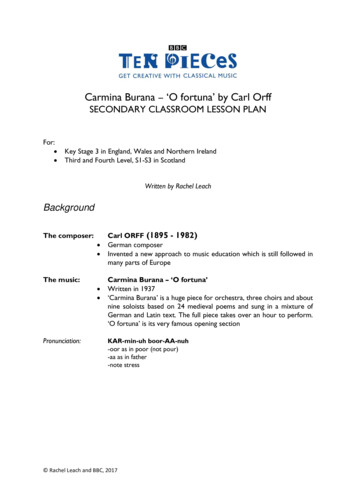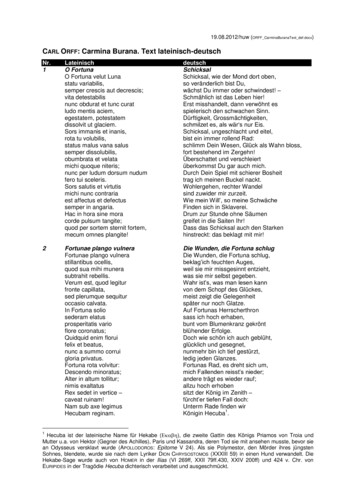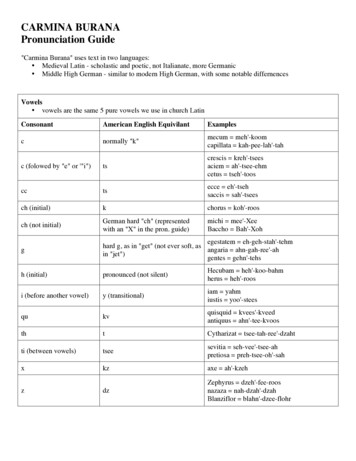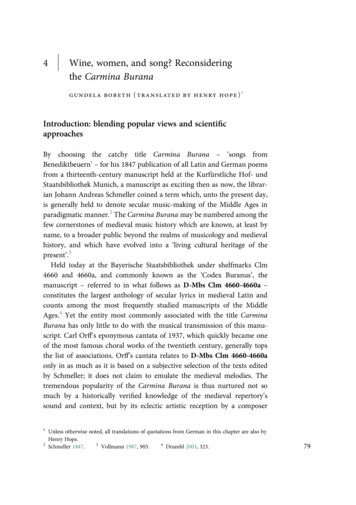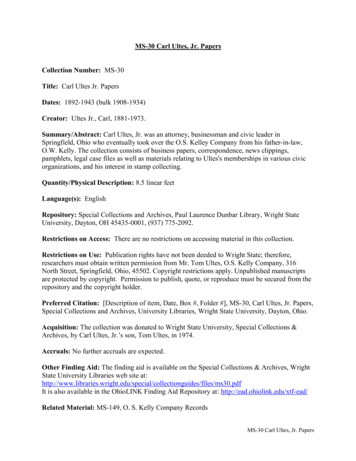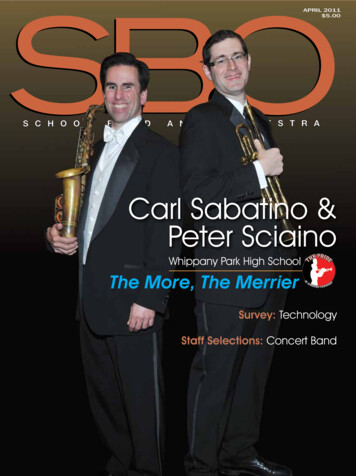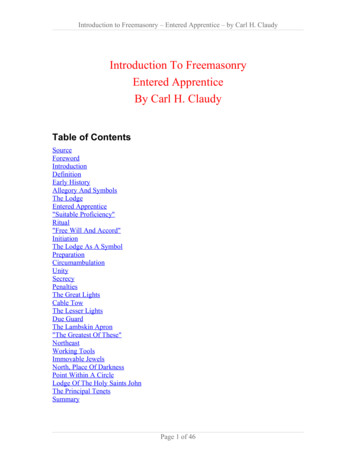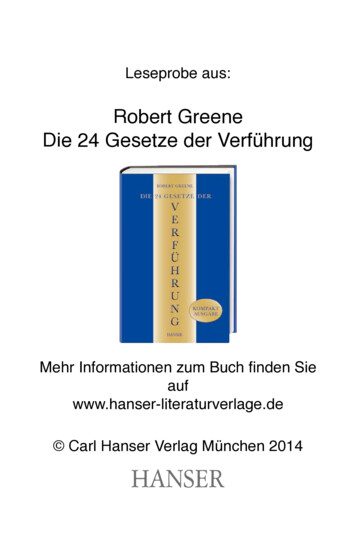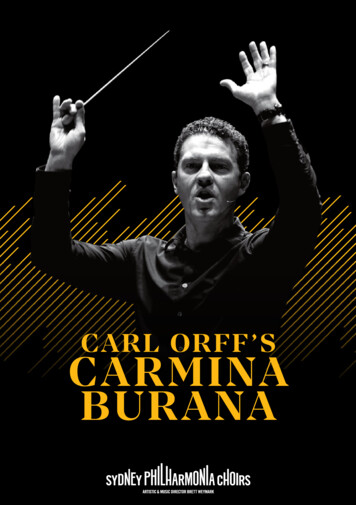
Transcription
CARL ORFF ’SCARMINABURANA
CONTENTSTap on an item in thelist to jump to that sectionTapto return to this pageWelcome4Introduction to the Program5About the Music8Texts and Translations 11From the Archives 18Artist Biographies 27Sydney Philharmonia Symphony Chorus 30NSW Public Schools Junior Singers 31Sydney Philharmonia Percussion Ensemble 31Our Supporters 32About Us 34
SYDNEY PHILHARMONIA CHOIRS PRESENTSCARL ORFF’SCARMINA BURANAACKNOWLEDGEMENT OF COUNTRYDEBORAH CHEETHAM and MATTHEW DOYLETarimi Nulay – Long time living here†PETER SCULTHORPESun Musicfor voices and percussion (1966)JOHN PETERSONThe Earth that Fire Touchesversion for soprano, choir, two pianos and percussion (2001/05)INTERVALCARL ORFF ARR. WILHELM KILLMAYERCarmina Buranaversion for soloists, choirs, two pianos and percussion (1937/56)Brett Weymark conductorPenelope Mills sopranoKanen Breen tenorJosé Carbó baritoneSydney Philharmonia Symphony ChorusNSW Public Schools Junior SingersCatherine Davis & Claire Howard Race pianosSydney Philharmonia Percussion EnsembleSaturday 22 May 2021, 3pmSydney Town Hall† Commissioned as part of our 100 Minutes of New Australian Music centenary projectin 2020. We’re delighted to be performing this work in our 2021 season.This performance of Carmina Burana by Carl Orff is given by permission ofHal Leonard Australia Pty Ltd, exclusive agent for Schott Music Ltd of Mainz.This performance will run for approximately1 hour and 50 minutes including a 20-minute interval
WELCOMECarmina Burana is one of the most popular works in the choralrepertoire – a set of secular songs that describes the rituals ofmediæval life, from romance to drinking and just about everythingin between.Today we perform a version for pianos and percussion, which notonly reveals the debt Carl Orff owes to Igor Stravinsky in workssuch as Les Noces, but also shines the spotlight on the choralforces, which are sometimes overwhelmed by the huge orchestralsound of the original. It felt like a great work to relaunch ourwonderful Symphony Chorus after the choir’s year-long absencefrom the concert platform.The first half features an all-Australian trio of works that highlightsthe forces employed in Wilhelm Killmayer’s version of CarminaBurana. Deborah Cheetham’s Acknowledgement of Country –Tarimi Nulay – evokes a timeless vision of Australia and the cultureof dancing and singing that has existed here for centuries. Morethan 50 years earlier, Peter Sculthorpe tried to capture his ownvision of Australia in Sun Music, an experimental work that openedthe door to him finding his own voice. A student of Sculthorpe’s,John Peterson, then finishes the first half with The Earth that FireTouches, a work that evokes the at-times destructive power of thenatural world. It reveals both the influence of Sculthorpe and theflavour of the American minimalist school with its emphasis onrhythm and repetition – exactly what Orff was exploring in his workabout defrocked monks and lusty youths!We hope you enjoy today’s performance. Thank you for joining us!Brett WeymarkArtistic and Music DirectorAcknowledgement of CountryTarimi Nulay – Long time living here wascommissioned for our Centenary year as achoral Acknowledgement of Country tocommence all concerts in the season. It waspremiered at the Dawn Chorus performanceon the steps of the Sydney Opera House atthe beginning of 2020 and we hope that thisspecial piece will be part of our performancesfor many years to come. Deborah Cheethamand Matthew Doyle have created a work thatexplores a profound cultural and spiritualreflection of the land on which we sing.SYDNEY PHILHARMONIA CHOIRS 2021 ///// 4
THE MUSICIn 1989, Boosey & Hawkes Australiacommissioned John Coburn to design ascreen print in celebration of PeterSculthorpe’s 60th birthday. The picture wascalled Sun Music – combining Coburn’siconic sun imagery (think of the Curtain ofthe Sun designed for the Sydney OperaHouse) and a reference to the series of “SunMusic” works that established Sculthorpe’sreputation in the 1960s. As a work of visualart, it was an apt tribute for a composerwhosecreativeinfluencesincludedAustralian modernist painters – RussellDrysdale, Sidney Nolan and Arthur Boyd –and who regarded Australia as a “preeminently visual culture, dominated by itslandscape”. At the same time, the sunsymbolism alluded to Sculthorpe’s enduringfascination with the “creative force of thesun” and to its duality – “both life-giver anddealer in death”.Another Coburn connection shows up inthis program with The Earth that FireTouches by John Peterson, a student ofSculthorpe’s and for some years his musicassistant. The central portion of the text istaken from a poem by Peter Skrzynecki, “TheThird Day: God Created the Earth (after JohnCoburn)”. That image, which took its finalform in tapestries that now hang in theKennedy Center, is designed around astylised tree of life. In Skrzynecki’s text:“From beneath the soil that fire touches/ andsurrenders water like a chrism – / two greenshoots begin to rise / towards an unbrokenand endless horizon.”NATIONAL LIBRARY OF AUSTRALIA, NLA.OBJ-148123235THE CIRCLEOF LIFEStudy for John Coburn’s Sun Music (1989)The characteristics of Coburn’s designs, atonce richly coloured and graphically simple,are echoed – in vastly different ways – inthese two Australian compositions.Sun Music for voices and percussionconveys the sizzling, scorching heat of theAustralian sun with techniques drawn fromthe vocabulary of the Polish avant-garde ofthe 1960s – blocks of static sound, forexample. Rather than a poetic text, the choiris given isolated syllables – explosive andhissing consonants, sighing and swoopingvowels. And the piano is played as if it’s agiant hammered dulcimer, using sticks andSYDNEY PHILHARMONIA CHOIRS 2021 ///// 5
THE MUSICwire brushes. Critic Roger Covell oncedescribed it as two players exploring“resonant auguries in the entrails of thepiano”. These sounds weren’t new butSculthorpe’s treatment of them in hismusical expression of the harsh Australianlandscape was.Responding to the evocation of the wideopen spaces of outback Australia inSkrzynecki’s poem, Peterson recognised amatch between the text and his own musicallanguage: “a style that uses up-temporepetitive music and rich harmonic colours inways that create a background ‘canvas’ ontowhich other instrument and vocal colourscould be superimposed.” There’s also, saysBrett Weymark, something of the influence ofthe American minimalists in The Earth thatFire Touches.It’s unsurprising that these two works,separated by nearly 40 years, are so differentin their sound. Sculthorpe’s tremendousPHOTO: OTTO MOLL CARL-ORFF-STIFTUNG/ARCHIV: ORFF-ZENTRUM MÜNCHENCarl Orff with the score of Carmina Burana (1938)influence on Australian music lay not in theestablishment of an Australian style but inthe establishment of a powerful sense ofAustralian identity. His musical language isso identifiable it defies imitation and all hiscomposition students have distinctive voices.Even so, these pieces are united bycommon themes – life (and death), the earthand the sun, the sacred in nature, growth andrenewal – and by common interests. Runningparallel to the influence of the landscape anda strong sense of place, Sculthorpe’s musicfrequently revealed his concern for theenvironment and the effects of our presenceon the planet. Expression of the landscapeand environmental concern – the terrors ofdrought and fire – are equally evident in TheEarth that Fire Touches. As Brett Weymarksays, its themes were topical when the musicwas first heard 20 years ago and they areeven more topical now.The themes of Carmina Burana are not somuch topical as timeless. You don’t have tobe a concert-goer to know how Carl Orff’smusic begins: a thumping chord from theensemble followed by the full-throated entryof the choir: “O Fortuna!” And you don’t haveto be a 13th-century renegade monk toappreciate the protest against the frustratingfickleness of Fate. This was the poem thatcaught Carl Orff’s imagination when he firstencountered the Carmina Burana texts andinspired him to write this scenic cantata, orto use its full title: “Carmina burana.Cantiones profanae cantoribus et choriscantandae comitantibus instrumentis atqueimaginibus magicis” (Songs from Beuern.Secular songs to be sung by singers andchoruses to the accompaniment of instruments and also of magic pictures).Those last words offer an important clue:Orff’s vision for Carmina Burana was as muchvisual as it was musical. It was conceived,SYDNEY PHILHARMONIA CHOIRS 2021 ///// 6
THE MUSICand premiered, as a staged work and it’s stillsometimes performed that way. WithCarmina Burana, Orff integrated his interestin mediæval drama and a belief in the unityof music and movement to achieve what hecalled Theatrum Mundi or “total theatre”.At the same time he revolutionised hismusical style. When, after the premiere, Orffasked his publisher to get rid of everythinghe’d written to that point and declared that“with Carmina Burana my collected worksbegin” he was likely making a strategic,ideological statement (this was 1930sGermany, after all) but musically it was true.As with Sculthorpe’s Sun Music series,Carmina Burana was to be the work thatmade its composer’s name and whichrepresented for him a distinctive new voice.Orff’s earliest work had veered betweencompositions in a late-Romantic vein, and, inthe 1920s, late Renaissance and earlyBaroque models. He’d also immersed himselfin making performing editions of Monteverdioperas. (His introduction for Monteverdi’sLamento d’Arianna was to become theopening phrase for “O Fortuna”.) In CarminaBurana, Orff adopts an almost elementalapproach and the melodic and harmonicsimplicity results in an infectious vitality thatfocuses attention entirely on the rhythms andthe texts.Those texts embrace moments of ecstaticmeditation, biting parody, teasing eroticism,and earthy pleasures; Carl Orff’s musiccaptures to perfection their marvellousvariety. And at the end of this exhilaratingcreation, he returns to his original inspirationwith a reprise of the “O Fortuna” chorus.Fortune’s wheel has turned full circle.Yvonne Frindle 2021“On opening it I immediately found, on thefront page, the long-famous picture of‘Fortune and her wheel’ and under it thelines O fortuna / velut luna / statuvariabilis Picture and words seized holdof me a new work, a stage work withsinging and dancing choruses at oncecame into my mind.” (Carl Orff)According to mediæval tradition, as Fortuneturns her wheel so the experience of thosewho ride it changes: I rule (top), I haveruled (tumbling down the side), I am withoutrule (naked and despairing at the bottom)and I will rule (climbing on the left).And Fortune had indeed smiled on Carl Orffwhen he spotted in a second-hand bookcatalogue a listing for the 19th-centuryedition of the Codex Buranus, a mediævalanthology of Latin, Middle High German andold French lyrics. This miscellaneouscollection of secular material – eroticpoems, drinking songs, satires, etc. – hadbeen hidden in the Benedictine monasteryof Beuern in Bavaria, likely to save it fromchurch censors. Its unnamed poets mayhave been wandering scholars, drop-outsfrom the ranks of the mediæval clergy, butit is one of the most important collections ofits kind. Thanks to Orff, the beauty and themaverick spirit of these lyrics have beenenjoyed by millions.SYDNEY PHILHARMONIA CHOIRS 2021 ///// 7
ABOUT THE MUSICPETER SCULTHORPE (1929–2014)rSltcupehorSun Music for voices and percussionPes ont erPeteJohndtarl-Orff-Stiftung C/Archiv:ffOr1in9 70m München)ntruZeff Or(Photo: Daniela-MariaanBryer (Schott Musiclma)Ki lCarlmelPeter Sculthorpe’s reputation as a leadingAustralian composer with a distinctive voicewas cemented in the 1960s by his SunMusic series, with its imagery of Australia asa sun-baked landscape – a place where thesun can be as much an enemy as a friend.The first work in the series wascommissioned for the Sydney SymphonyOrchestra in 1965. Sun Music for voices andpercussion (as it eventually came to beknown) was completed the following year forDonald Peart and Sydney University’s ProMusica Choir and was premiered by them atthe 1966 Adelaide Festival.The music is striking – and unusual – fortwo features: there is no sung text, insteadthe choir is given phonetic syllables, and thepiano’s strings are played like a harp orhammered dulcimer, its keyboard remaininguntouched. Listen for sustained passagesusing sounds such as [sh] and [ah], thecontinuous vocal swoops and glides, andrhythmic chanting using plosive consonantssuch as [b] and [k]. “This makes it sound afearful cacophony – but it wasn’t,” wrote thecritic Frank Harris in 1966. “There was anabsolute rightness which marks PeterSculthorpe as a major composer.”As John Peterson explains, the concepts ofmelodic line and harmonic resolution have noeffect on the outcome in this piece, insteadthe drama of the music derives from the waySculthorpe juxtaposes blocks of colour andeffects, much as he’d done in Sun Music I.The result is intense and shimmering.WilhSYDNEY PHILHARMONIA CHOIRS 2021 ///// 8
THE MUSICJOHN PETERSON (born 1957)CARL ORFF (1895–1982)The Earth that Fire TouchesCarmina Burana, arr. Wilhelm KillmayerThis work for soprano, chorus, two pianosand percussion is an evocation of theAustralian bush and the vastness of theoutback. Peterson was drawn to PeterSkrzynecki’s poem “The Third Day ” for itsreferences to rebirth after bushfire, and heframed this text with selections from themore “claustrophobic” poem “Armageddon”to create a three-part structure.The first section is mysterious, almostmystical – evoking the experience of solitudein the bush: hearing bird calls and the noisesof unseen animals, and the feelings ofapprehension and expectation, especially atnight. The second section emerges as acelebratory dance of rebirth, acknowledgingthe extraordinary way nature rejuvenatesafter devastating bushfires or from theincessant heat o
CARMINA BURANA ACKNOWLEDGEMENTOFCOUNTRY DEBORAHCHEETHAMandMATTHEWDOYLE TarimiNulay–Longtimelivinghere† PETERSCULTHORPE SunMusic forvoicesandpercussion(1966) JOHNPETERSON TheEarththatFireTouches 1/05) INTERVAL
